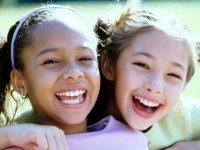A Lesson Plan for Helping Young Children Learn to Accept Differences
Teachers can help children learn about differences by presenting them with vignettes and then giving them tools to analyze what they have heard and seen.
How do we get young children to accept differences? First, we have to recognize that for many young children, "differences" are disconcerting. Even though a pre-K or kinder student may not be able to articulate it, they are often put off by differences. Sometimes it's because they can't explain what they perceive. Other times, they are not sure of the implications of the differences and may fear for their own safety.
Second, we have to recognize that these reactions tend to be developmentally normative and adaptive. Just as we discourage children from talking to, and certainly to going with, strangers, children themselves are hesitant to embrace what they see as truly different.
So of course, this illustrates the importance of children being exposed to diversity from very early in their lives, to reduce their sense of unfamiliarity and threat. Schools can help with this process by presenting children with vignettes, either verbally, in puppet play, or videos, and then giving them tools to analyze what they have heard or seen.
In the Classroom
Here is a model from a book titled Social Decision Making/Social Problem Solving: A Curriculum for Academic, Social, and Emotional Learning, Grades K-1:
1. Present the Story
Read the following story to the class. Give each child a copy to follow along if possible.
2. Ask Guiding Questions
Here is the set of questions one can ask of any story, adapted to this story:
- In what ways is [Jamar] different? (He is from another country, he speaks and dresses differently and eats different foods.)
- How do the kids treat [Jamar]? (They tease him and call him names, they don't let him play games.)
- Why do you think they don't treat [Jamar] well? (He is not friendly, his clothes are funny looking, his food is smelly and weird.)
- What kind things do you think you could do to help you get to know [Jamar] better? (Ask him to play, sit with him at lunch, ask him questions about where is from, pick him to be on your team during gym, introduce yourself.)
- What are some of the things you could do that might make [Jamar] uncomfortable, and make it harder for you and [Jamar] to become friends? (Make fun of his clothes, make fun of the way he talks, make fun of the food he eats, never pick him for teams or invite him to participate in activities.)
3. Deepen With a Personal Reflection
Generally, that would take the form of asking students to think about a time when someone made fun of them. Was it because of the way they look? Was it because they couldn't do something? How did it feel to be made fun of? Have them share their experiences with one another in small groups or as a whole group.
4. End With a Reflective Summary
Ask students what they learned from today's lesson. Be sure that they got the key points (differences are not necessarily bad; you can't always tell about someone based on their food, clothing, language; people deserve to be treated kindly and then usually treat you kindly in return), and then introduce the follow-up.
5. Follow-Up After the Lesson
Tell the group that their job in the next week is to practice being kind to others. Ask the group to do something kind for another individual. Suggest that they say nice words to someone who is different from them on the playground, someone they usually don't talk to. Set a time to review children's experiences of giving or receiving kindness from others in the school. Where appropriate, connect this lesson to school discussions about bullying. Take the time to review your school's anti-bullying policies in an age-relevant manner.
You will find that children ages four to six are particularly receptive to this lesson format. Repeated with various vignettes (which could be created by you as fictionalized, "hypothetical" versions of what might really be happening or about to happen in school), this approach begins to give students a mindset for approaching situations involving differences.
References
Bruene, L., Romasz-McDonald, T., & Elias, M. J. (2011). Social Decision Making/Social Problem Solving: A Curriculum for Academic, Social, and Emotional Learning, Grades K-1. Champaign, IL: Research Press.
